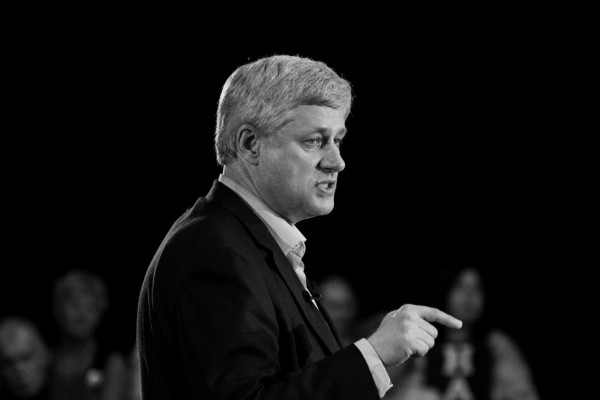On the dangers of nationalism and national symbols
In this era of racial and economic injustice, it’s time to debate the use of the Maple Leaf flag

A Canadian flag is strapped to the grill of a semi-trailer truck during protests against COVID-19 measures in Ottawa, February 2022. Photo by GoToVan/Flickr.
With the recent dispersal of the trucker demonstrations against vaccine mandates in Ottawa and in other parts of the country, national symbols like flags and representations of so-called “freedom” have been thrust into public view. Sadly, in many parts of Canada, it’s not hard to go far without seeing a car or truck boldly and dangerously displaying an oversized Canadian flag.
To say nothing of how prominently displayed flags by motorists are public safety hazards, these developments also signal a dangerous escalation of aggressive nationalism that smacks of the 20th century’s worst examples: from British and American imperial hubris in colonial and neo-colonial endeavours, to German, Japanese, and Soviet authoritarianism.
A recent editorial suggests that the Canadian flag needs to be reclaimed and redeployed to re-affirm national symbols as part of a progressive movement of unity. This is very tricky ground, however, since nationalism in nearly all its forms (historic and present day) often leads to more problems and divisions.
Perhaps it’s time for another “great flag debate,” as occurred in Canada during the 1960s, or even better, a debate about whether we even need national symbols with obvious historic baggage in a pluralist democracy.
Canada is like the United States
Just like Americans after January 6, 2021 who might recoil at the misuse and abuse of stars and stripes imagery, is it possible that a majority of Canadians can no longer abide by cavalier acceptance of parallel national symbols in our culture?
In Ottawa and at other locations across Canada, flags flown alongside both upright and upside-down maple leaves ran the gamut of US libertarian (such as the Gadsen Flag which dates from the 18th century and reads “Don’t Tread on Me”) to explicit Nazi flags and images.
Such imagery has led to justifiable expressions of outrage and concern over the frightening potential direction these protests could move in as far-right forces seek to recruit from populist formations in the current period. Scholars have already pointed out the myth of Canada’s supposed mid-20th century role as a “peacekeeping” nation and presented a more nuanced understanding of this country as a minor global imperial power that has operated more as an aggressive settler colonial state largely in line with America’s world-ordering ambitions.
In these protests, we can also see an alarming lack of basic “civic education” as misinformation about vaccine science proliferates alongside fundamental understandings of how political and electoral systems function in a democracy. Patriotism can be a dangerous force and when it extends beyond things like supporting a hockey team, it can frequently become about limiting the freedoms of the most marginalized, the infirm, and those who don’t ostensibly represent an ethnic majority in colonial settler nation-states like Canada.
In essence, patriotism can be and is, often, downright destructive.
Canada Day in 2021 was marked by sombre yet critical public commemorations to the thousands of Indigenous children and their families impacted by the legacies of colonial racism and state and church-sanctioned violence carried out through the system of residential schools in existence through much of the last century. Many Canadians who had never before questioned their patriotism on July 1, began to do so as they donned orange t-shirts and put away the red and white symbols of Canada Day in honour of the people impacted by these colonial histories and present realities.
In light of the aggressive nationalism on display with the recent protests against vaccine mandates, perhaps it’s time we as Canadians truly reckon with the symbols of ostensive freedom we have grown up with. Even the iconic national beaver, one scholar has shown, served to promote Canadian settler ideals of “northern” identity whilst reinforcing racist images of Inuit and Indigenous peoples across the north of Turtle Island.
False perceptions a driving force
We live in polarized times, and it is likely a majority of Canadians live with uncertain economic futures in light of the forces unleashed by the global pandemic. However, it has been shown that many of those who recently protested mandates are not simply upset over vaccines, but perceive their social status to be “under threat” and therefore feel “entitled” to express their grievances in coded (and sometimes not-so coded) racial and gendered identitarian terms.
These entitlements are based largely on illusions about who has been most impacted by recent economic inequities, notably the disproportionate number of racialized groups (Black and Latinx) in particular who have faced the greatest levels of economic inequity—just like in the US—based on weekly earnings in recent years. Overt and emotional displays of Canadian patriotism months away from July 1 have done much to occlude these present, material realities and inequities for those minority of Canadians swayed by the sentiments of recent protests.
One can only hope that the dangerous forces of nationalism unleashed by such happenings will be held in check in the months ahead, and that such affective and destructive political inclinations and behaviours do not spread to larger segments of the population.
Ian Rocksborough-Smith teaches US and Canadian history at the University of the Fraser Valley.










